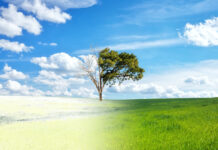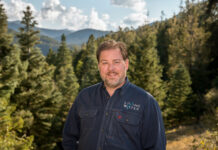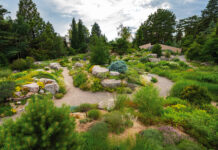Have you watered your yard lately? You probably should.
Such a recommendation might seem irresponsible in the face of the California drought, but the recent rush to slash urban landscape water use, and in the process let trees, shrubs and lawns decline or die, is shortsighted, foolish, expensive and, most tragic of all, unnecessary.
It’s shortsighted because the urban landscape provides numerous benefits and amenities that add immeasurably to the quality of our lives. To list just a few, trees, shrubs and lawns provide: beauty and ornament; shade and energy savings in heating and cooling; privacy; food; wildlife habitat; oxygen; jobs; carbon sequestration to help mitigate global warming; rain capture for dust and erosion control; enhanced property values; recreational opportunities; cultural and historic value; and even psychological well-being.
One Canadian study this year showed that having 10 more trees on a city block improves health perception (or the feeling of wellness) in ways comparable to an increase in annual personal income of $10,000, moving to a neighborhood with a $10,000 higher median income, or being seven years younger.
It’s foolish because urban landscape irrigation accounts for such a small part of the water used in California. Although it’s true that 50 percent of residential water use takes place outdoors, data show that less than 9 percent of the developed water used in California ends up on the urban landscape. So if we never watered another tree, shrub, ground cover, lawn or flower again in California, the state would save at the most 9 percent of its water.
It’s expensive because, as landscapes go dry, the direct costs could be enormous to manage and clean up dead and dying trees, retrofit irrigation systems and replant landscapes. Also, numerous indirect or hidden costs are associated with this strategy, including lawsuits over property damage and human injury or even death from failing trees, increased fire risk and, in the long-term, lost jobs and reduced economic activity for gardeners and landscapers.
It’s tragic because research at the University of California over the last 30 years shows that through appropriate landscape water management—the right amount, at the right time—we can reduce water use 30 percent or more. We could therefore meet most of the mandated cutback goals yet still retain our trees, shrubs, ground covers and, yes, even some area of lawn. It’s absolutely unnecessary to let them go brown and die. It’s also unnecessary to make wholesale changes in our landscape palette, ripping out established flora and replanting with “drought tolerant” plants, to save water. Our research has shown that most of our trees, shrubs and ground covers in California if planted, established, and cared for and irrigated properly are already quite drought tolerant.
The poorly crafted landscape water conservation rules, such as watering only two days a week and/or only 15 minutes of run time per station, are horticulturally unsound, because they do not take into account sprinkler precipitation rates, soil types, soil water-holding capacity, plant type or rooting depth, among other factors. The no-water-on-lawn-medians decree takes the prize for ignorance, though, because most cities have stopped watering their medians entirely without making provisions for the trees. As the lawns go brown, the trees are declining and dying.
Lawns have of course been especially singled out as water-wasting culprits and borne the brunt of the anti-water scorn—but this, too, is unscientific. They account for only about 3 to 5 percent of all the water used in California. And our research has shown that warm-season grasses need 20 percent less water than tall fescue, the most common lawn grass; thus, significant savings can be attained without doing away with lawns completely and instead simply changing them from tall fescue to a warm-season grass.
Replacing lawns with artificial turf isn’t a good idea; turf, in fact, has serious environmental drawbacks, among them increased surface temperatures, heat collection and retention, lack of carbon sequestration, no absorption of greenhouse gases, and increased water run-off—as well as the fact that turf is plastic-based and thus a petroleum product.
Official but unacknowledged state policy for the last decade has been to support water demand for future growth primarily by trying to wring out savings through urban landscape water conservation. But with the state projected to add 10 million people by 2025, and with landscape irrigation accounting for such a small portion of the water used in the state, any sixth-grader can do the math and see that this is a nonsensical approach.
What’s the policymakers’ agenda here? The strategy is not so much to achieve significant statewide water savings—because there simply isn’t that much to save—but rather to put the screws to homeowners so they will feel inconvenienced and, therefore, be more willing to support future controversial state water projects, like the gigantic twin tunnels under the Sacramento-San Joaquin Delta.
Urban dwellers and homeowners make easy targets because there is no one unified voice with abundant resources that can advocate for them. But it’s misguided to single out urban landscape water use. Even in this historic drought, landscape and especially trees are worth having and saving. We can have our landscape—and still save water.
This op-ed piece originally appeared on the LA Times website here.
Donald R. Hodel and Dennis R. Pittenger each have more than 30 years of experience as UC Cooperative Extension advisors who specialize in the selection and management of trees and landscape plants, including irrigation.











![[VIDEO] Dickies®: Discover Workwear That’s Anything But Uniform](https://turfmagazine.com/wp-content/uploads/2023/06/1647663814-4b1a2a7742790a9b1e97a3b963477850192e1d6a9dfba9b07214a77bae25d6e3-d-218x150.jpg)






























![[VIDEO] Dickies®: Discover Workwear That’s Anything But Uniform](https://turfmagazine.com/wp-content/uploads/2023/06/1647663814-4b1a2a7742790a9b1e97a3b963477850192e1d6a9dfba9b07214a77bae25d6e3-d-324x160.jpg)